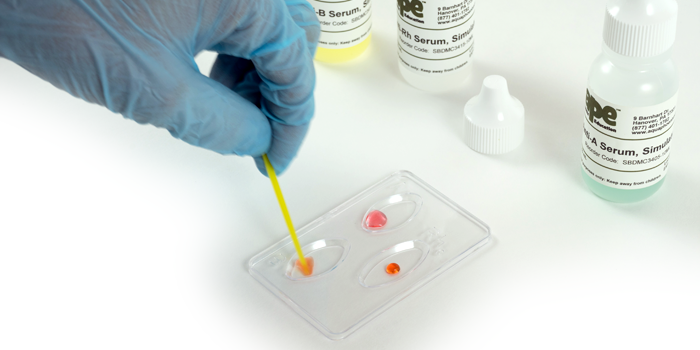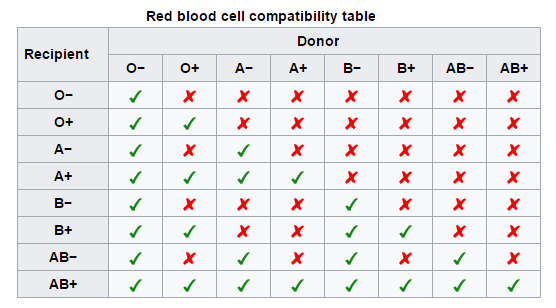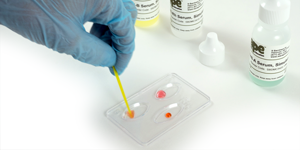Students Explore Blood Type Chemistry
With a convenient science kit and unmarked synthetic blood samples, students get hands on with the science behind blood typing. Can you correctly identify the "type" of the mystery blood samples?

Blood. It keeps the body alive.
Thanks to the circulatory system, our blood travels through our bodies all day every day, continuously delivering oxygen, fuel, and nutrients to our cells and helping transport carbon dioxide and waste to organs that remove these byproducts from the body.
Our blood has to be healthy, and we have to have enough of it to keep our bodies running properly. When there is a problem or accident that results in blood loss, receiving additional blood may be necessary. Luckily, blood banks store blood for this purpose, and many people donate blood to blood banks around the world to help in medical emergencies. When you need blood, however, it is important that you receive blood that will "work with" your own blood.
The kind of blood you have is referred to as your Blood Type. Our blood type is determined by the presence or absence of three antigens: antigen A, antigen B, and the Rhesus factor (Rh).
Using the presence or absence of these antigens as the basis for identifying a person's blood type, there are 8 possible blood types: O positive, A positive, B positive, AB positive, O negative, A negative, B negative, and AB negative. For each type, the letters used in the blood type signal which of antigen A and B are present. For example, Type A blood has antigen A. Type B blood has antigen B. Type AB has both antigen A and antigen B. Type O indicates the blood has neither antigen A or antigen B. The presence or absence of the Rh factor is noted as "positive" (present) or "negative" (absent). So, someone whose blood is "AB positive" has both antigen A and antigen B and the Rh factor.
Not All Blood can Mix
In an emergency, donated blood can be lifesaving. Unfortunately, not all blood types are compatible with each other. Some blood types can mix with a variety of other blood types, and some cannot be safely mixed. Today's blood typing system is a combination of the ABO blood group system and the Rh system. As a whole, these systems of identifying and labeling blood help ensure that people are given only blood that is compatible with their own blood type. O negative blood, for example, is called the "universal donor" and can be given to someone with any blood type. On the flip side, someone with O negative blood can only receive blood that is also O negative. Someone with AB positive blood, on the other hand, can receive blood from anyone, making this blood type the universal recipient.
The compatibility chart shown below helps illustrate typical blood type compatibility. (Note: there may be compatibility exceptions in the presence of other medical factors.) What deductions can you make from studying this chart?

The Science of "Typing" Blood
So how do you know what "type" blood is? To find out, you have to use a process that lets scientists determine whether or not each of the antigens is present or absent in the blood. The process involves using antibody reagents that react to A, B, and Rh antigens. These reagents, called anti-A, anti-B, and anti-Rh are applied, individually, to samples of the blood. By evaluating how the blood reacts (or doesn't react) to each antibody reagent, the type can be determined.
When typing blood, scientists are looking for signs of visible reaction between the reagent and the blood. Specifically, they are looking to see if the blood clumps (agglutination) in the presence of the antibody reagent. If there is visible reaction, the blood is "positive" for that specific antigen. Once you can determine if the blood is positive or negative for each of the three antigens, you can label it.
Hands-on Student Science
Students can experiment with the process of blood typing in the How Are Antibodies Used for Blood Typing? medical biotechnology project. Using synthetic blood samples and synthetic antibody reagents in the project kit, students experiment to determine the blood type of four synthetic blood samples, for which the type is unknown.
A guided procedure helps students move step by step through the blood typing process. Students gather data for all tests and trials and are assisted in evaluating their reactions by comparing what they see in their testing wells with photos in the project that highlight the kinds of visible changes students will see when presence of an antigen has been detected.
The How Are Antibodies Used for Blood Typing? project helps demystify the process of blood typing and helps students better understand the importance of this system.
Categories:
You Might Also Enjoy These Related Posts:
- Plastics and Earth Day - Science Projects
- Arduino Science Projects and Physical Computing
- 10+ Robotics Projects with the BlueBot Kit
- 5 STEM Activities with Marshmallow Peeps
- March Madness Basketball Science Projects: Sports Science Experiments
- Women in STEM! More than 60 Scientists and Engineers for Women's History Month
- Explore Artificial Intelligence and Machine Learning with Student AI Projects
- 10 Reasons to Do the Rubber Band Car Engineering Challenge










